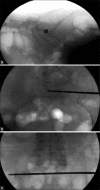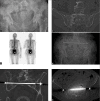Trans-iliac-sacral-iliac-bar procedure to treat insufficiency fractures of the sacrum
- PMID: 19838346
- PMCID: PMC2762184
- DOI: 10.4103/0019-5413.53454
Trans-iliac-sacral-iliac-bar procedure to treat insufficiency fractures of the sacrum
Abstract
Background: Osteoporosis is an increasing problem attributed to the greater longevity of the population and the incidence of fractures related to osteoporosis. The presence of osteoporotic bone, comorbidities, and functional status of the patient require adequate solutions to improve the clinical outcome of sacral insufficiency fractures. Conservative treatment by means of prolonged bed rest and analgesics are associated with increased risks and complications. A sacroplasty significantly improves the functional outcome. We describe the trans-iliac-sacral-iliac-bar (TISIB) procedure and our clinical experience to treat insufficiency fractures of the sacrum.
Materials and methods: The records of 19 consecutive patients with a mean age of 71.7 years (range: 57-82 years) who had been managed with a TISIB procedure from 2005 till 2007 were reviewed retrospectively. There were 15 females and 4 males. Predisposing factors for sacral insufficiency fractures were osteoporosis (n = 12, 63%), radiotherapy (n = 6, 32%), and rheumatoid arthritis (n =1). Diagnosis with a mean delay of 3.7 months was mainly made by CT. All patients were preoperatively and at follow-up assessed by means of the visual analogue score (VAS), analgesic consumption, and the ability to perform activities of daily living (ADLs) using a 5-point pain scale: 1, without pain; 2, mild pain; 3, moderate pain; 4, severe pain and, 5 unable to perform ADLs because of pain.
Results: The average duration of postoperative follow-up was 9 months (range: 3-24.5 months). No neurological complications occurred during the surgery. A postoperative radiographic study showed a well-positioned bar in every case. The mean VAS improved 44.7 mm (preoperative: 67.8; at follow-up: 23.2). Fifteen patients (79%) consumed narcotic analgesics before surgery, and only one (5%) at follow-up; two patients (10%) consumed NSAIDS before surgery and three (15%) after. Two patients (10%) consumed minor analgesics before, and 11 (58%) after the procedure. Finally, four patients (21%) were not taking any analgesics at follow-up. Before surgery, 9 patients (47%) were able to perform ADLs with a pain score of 4; 6 (32%) with a score of 3, and 4 (21%) a score of 2. At follow-up 1 (5%) did have a score of 4; 1 (5%) a score of 3, 8 (42%) a score of 2 and 9 (47%) a pain score of 1.
Conclusion: A TISIB PROCEDURE RELIES ON THE PRINCIPLES OF FRACTURE TREATMENT: fracture stabilisation and compression. The incapacitating problem of an insufficiency fracture of the sacrum can be elegantly solved by means of this minimally invasive procedure. A near-immediate improvement is noticed when looking at the VAS score, analgesics consumption, and the ability to perform ADLs.
Keywords: Elderly; bar; fracture; insufficiency; minimally invasive; osteoporosis; sacrum.
Conflict of interest statement
Figures



Similar articles
-
Multicenter study to assess the efficacy and safety of sacroplasty in patients with osteoporotic sacral insufficiency fractures or pathologic sacral lesions.J Neurointerv Surg. 2013 Sep 1;5(5):461-6. doi: 10.1136/neurintsurg-2012-010347. Epub 2012 Jun 8. J Neurointerv Surg. 2013. PMID: 22684691
-
Percutaneous sacroplasty for osteoporotic sacral insufficiency fractures: a prospective, multicenter, observational pilot study.Spine J. 2008 Mar-Apr;8(2):367-73. doi: 10.1016/j.spinee.2007.05.011. Epub 2007 Jul 20. Spine J. 2008. PMID: 17981097
-
Percutaneous Sacroplasty for Non-neoplastic Osteoporotic Sacral Insufficiency Fractures.Pain Physician. 2017 Feb;20(2):89-94. Pain Physician. 2017. PMID: 28158156
-
Safety and Efficacy of Sacroplasty for Sacral Fractures: A Systematic Review and Meta-Analysis.J Vasc Interv Radiol. 2019 Nov;30(11):1845-1854. doi: 10.1016/j.jvir.2019.06.013. Epub 2019 Oct 3. J Vasc Interv Radiol. 2019. PMID: 31587952
-
Safety and efficacy of percutaneous sacroplasty for treatment of sacral insufficiency fractures: a systematic review.J Spine Surg. 2019 Sep;5(3):365-371. doi: 10.21037/jss.2019.06.05. J Spine Surg. 2019. PMID: 31663048 Free PMC article. Review.
Cited by
-
A Systematic Review of Sacral Insufficiency Fractures: Treatment Modalities and Outcomes.Cureus. 2023 Jul 11;15(7):e41745. doi: 10.7759/cureus.41745. eCollection 2023 Jul. Cureus. 2023. PMID: 37575865 Free PMC article. Review.
-
When and How to Operate Fragility Fractures of the Pelvis?Indian J Orthop. 2019 Jan-Feb;53(1):128-137. doi: 10.4103/ortho.IJOrtho_631_17. Indian J Orthop. 2019. PMID: 30905993 Free PMC article.
-
[Quantification of treatment success for geriatric sacral fractures].Unfallchirurg. 2019 Apr;122(4):293-298. doi: 10.1007/s00113-018-0511-x. Unfallchirurg. 2019. PMID: 29797033 Review. German.
-
Iliac Bone Corridors to Host the Transiliac Internal Fixator-An Experimental CT Based Analysis.J Clin Med. 2021 Apr 4;10(7):1500. doi: 10.3390/jcm10071500. J Clin Med. 2021. PMID: 33916524 Free PMC article.
-
In-screw cement augmentation for iliosacral screw fixation in posterior ring pathologies with insufficient bone stock.Eur J Trauma Emerg Surg. 2018 Apr;44(2):203-210. doi: 10.1007/s00068-016-0681-6. Epub 2016 May 11. Eur J Trauma Emerg Surg. 2018. PMID: 27167237
References
-
- Garant M. Sacroplasty: a new treatment for sacral insufficiency fracture. J Vasc Interv Radiol. 2002;13:1265–1267. - PubMed
-
- Frankel BM, D'Agostino S, Wang C. A biomechanical cadaveric analysis of polymethylmethacrylate-augmented pedicle screw fixation. J Neurosurg Spine. 2007;7:47–53. - PubMed
-
- Vanderschot P. Treatment options of pelvic and acetabular fractures in patients with osteoporotic bone. Injury. 2007;38:497–508. - PubMed
-
- Taillandier J, Langue F, Alemanni M, Taillandier-Heriche E. Mortality and functional outcomes of pelvic insufficiency fractures in older patients. Joint Bone Spine. 2003;70:287–289. - PubMed
LinkOut - more resources
Full Text Sources
Research Materials
Miscellaneous
